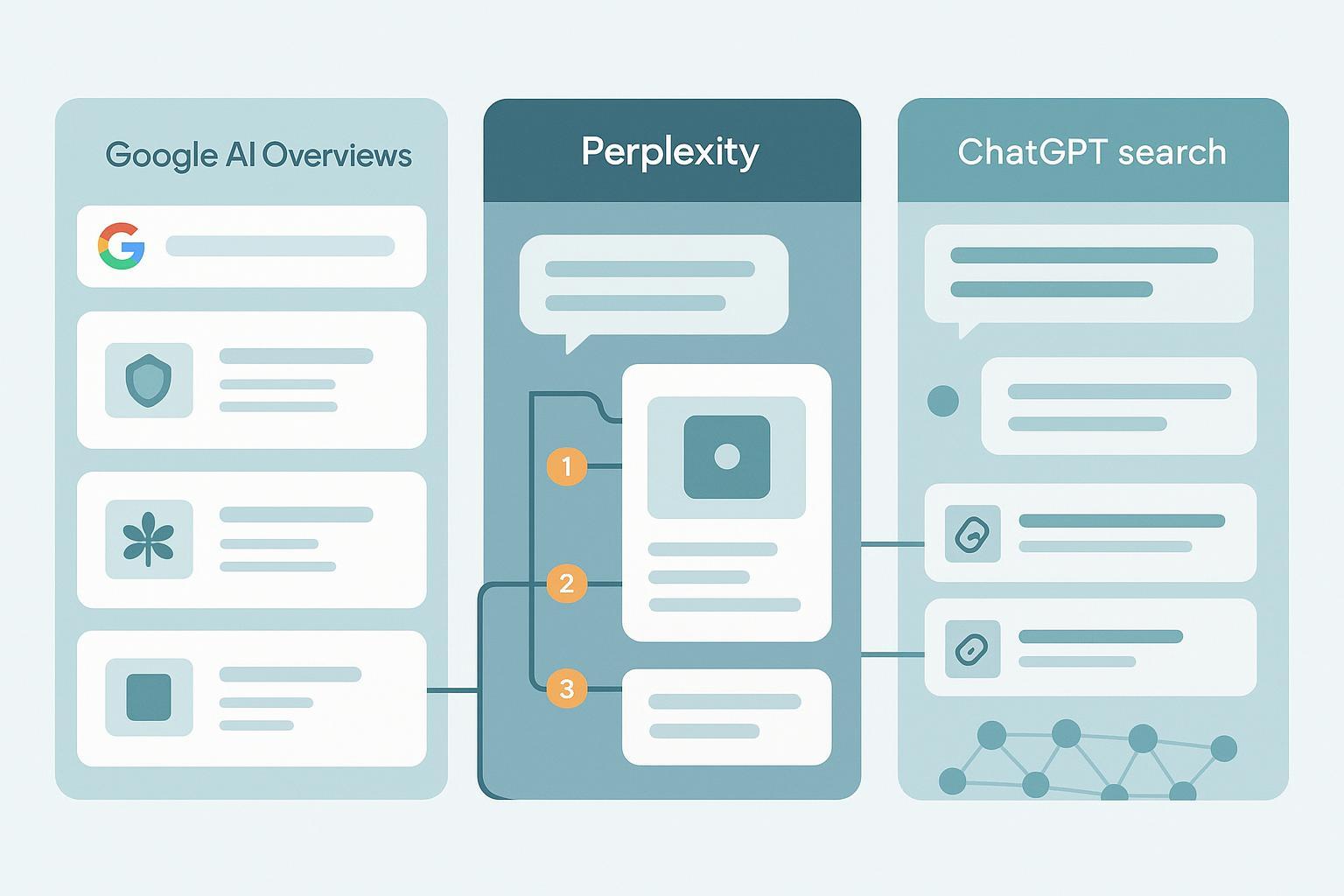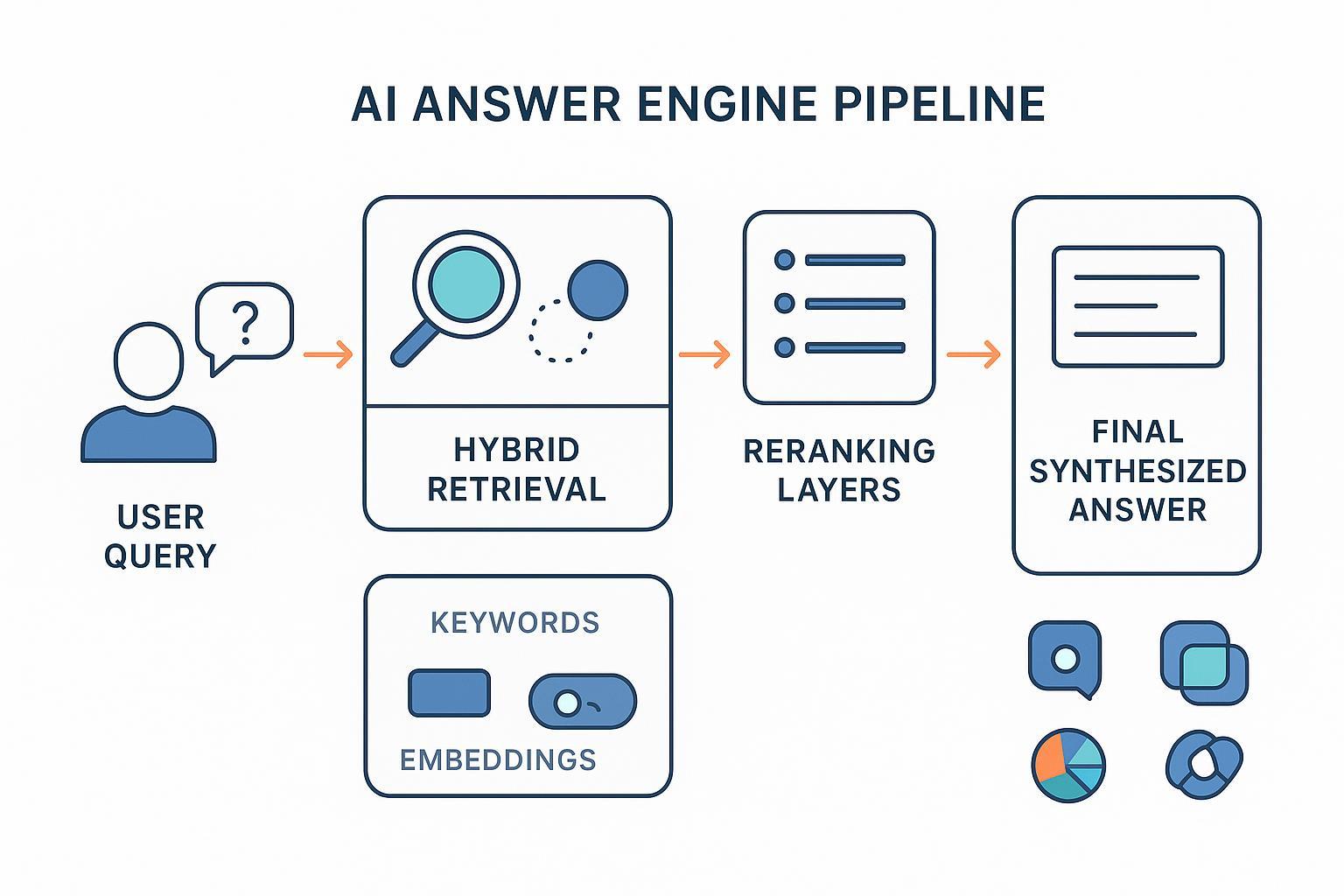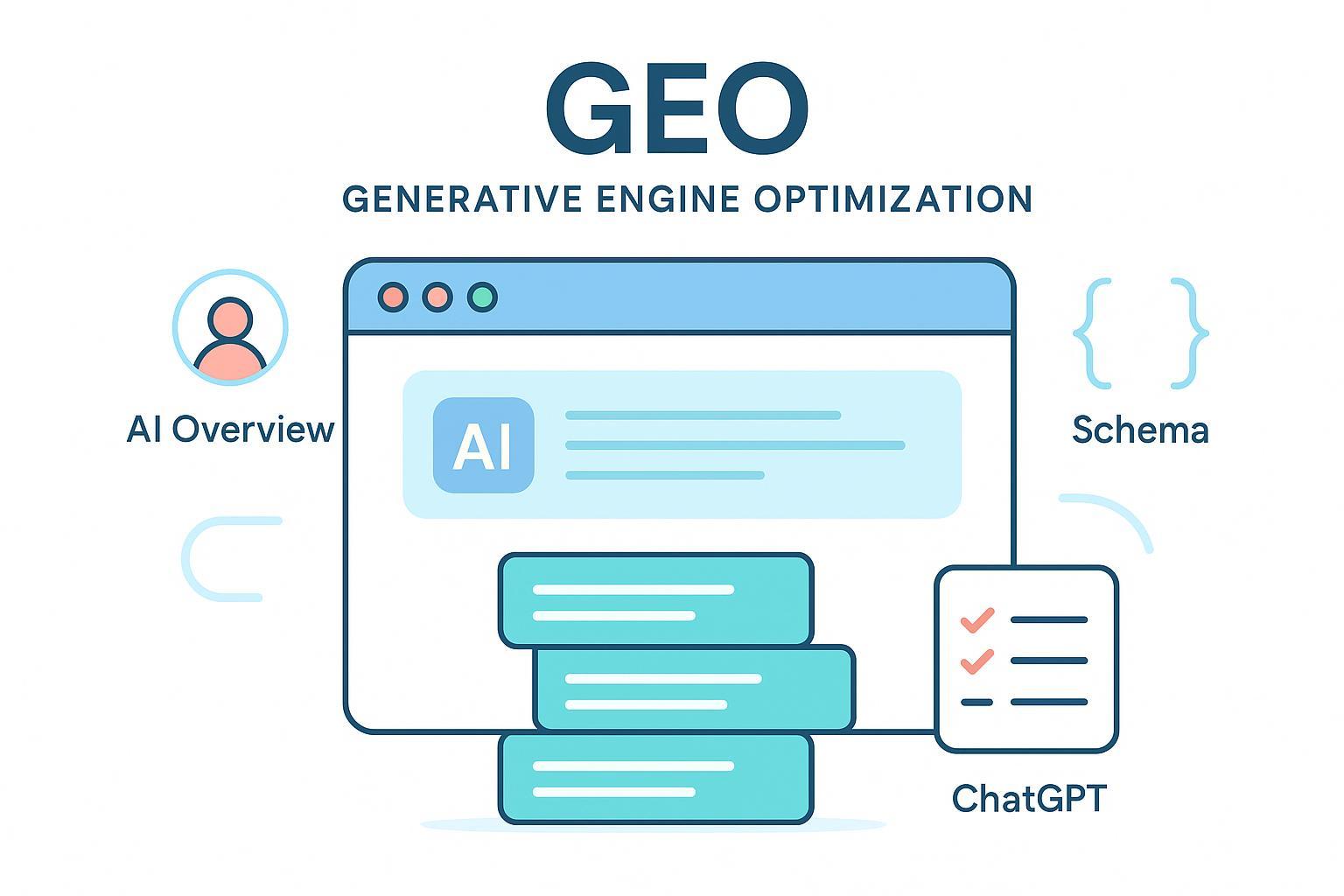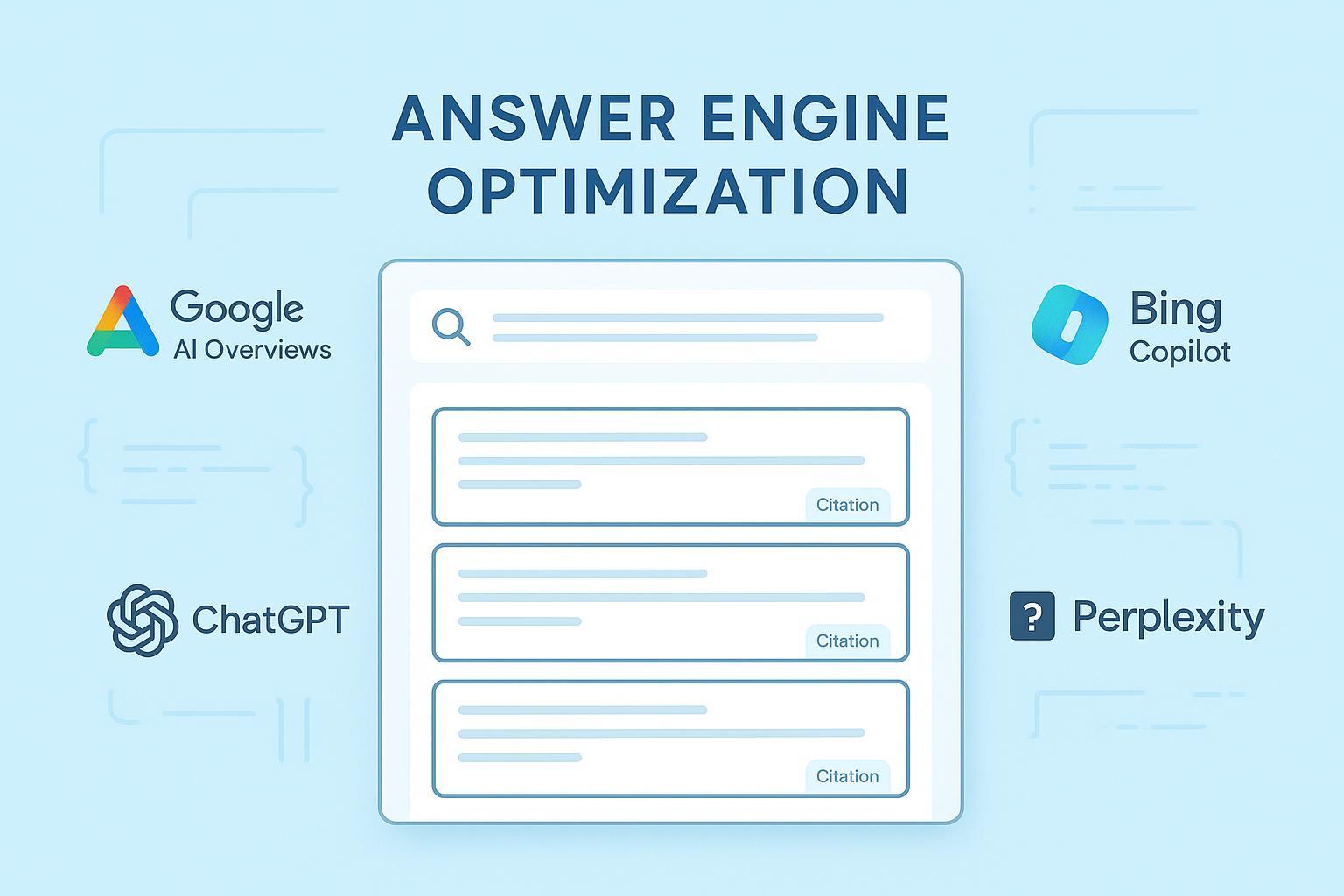Best Practices for AI Answer Engine Content Optimization (2025)
Expert workflows and strategies for optimizing content to rank and earn citations in AI answer engines—Google AI Overviews, Perplexity, Bing Copilot, ChatGPT—in 2025. Actionable AEO practices, schema markup, and brand authority methods.

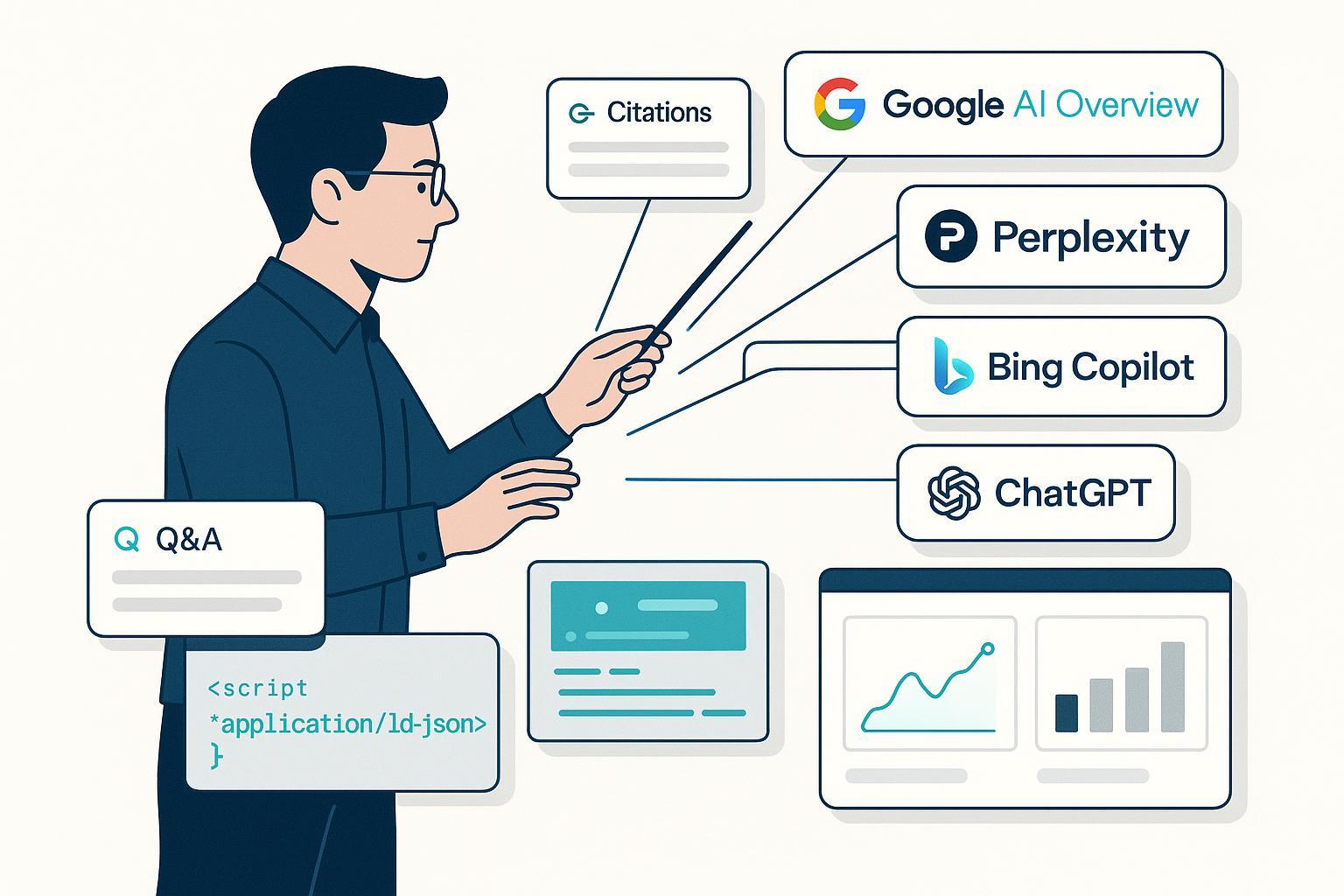
Why AI Answer Engines Change the Game
If your playbook still centers on ranking a single URL for a target keyword, you’ll miss where attention is moving. AI answer engines—Google AI Overviews, Perplexity, Bing Copilot, and ChatGPT with browsing—synthesize answers from multiple sources and show only a handful of citations. In practice, visibility shifts from “ranking a page” to “earning a citation as part of a synthesized answer.”
Based on 2025 field work and platform guidance, three realities shape your strategy:
- Answers are synthesized from few sources. Studies in 2025 show AI modules often cite a small set of sources per query, concentrating visibility among those included (e.g., with UK analyses by Barry Adams and SISTRIX in 2025, and large-scale U.S. samples by Search Engine Land in 2025).
- Structured, verifiable, and concise content is favored. Google’s Search Central guidance in 2025 emphasizes clarity, authorship, and structured data for success in AI Search.
- Entity-level authority matters more. Clear authorship, organizational identity, and credible outbound references increase your odds of being “citation-worthy,” not just “rank-worthy.”
According to Google’s 2025 guidance on AI Search, aligning content to be clear, accurate, well-sourced, and structured is foundational to visibility in AI features, not only classic blue links. See the official patterns in the 2025 Search Central post on succeeding in AI Search: Google Search Central — Succeeding in AI Search (2025).
What’s Different from Traditional SEO—In Practice
- Citation over position: In AI Overviews, inclusion as one of the few cited sources is the objective. Search Engine Land’s 2025 analysis of 8,000 AI citations discusses how fewer sources capture most exposure: Search Engine Land — 8,000 AI citations analysis (2025).
- Variable prevalence by vertical: AI Overviews haven’t fully replaced SERPs. Semrush’s 2025 study and Search Engine Land’s May 2025 rollup place AI Overview prevalence roughly in the low-to-mid teens overall, with vertical spikes: Semrush — AI Overviews study (2025) and Search Engine Land — AI Overviews in 13% of searches (2025).
- Source selection isn’t strictly the top 10. In 2025 UK tracking, Barry Adams notes that AI Overviews and similar features pull from a diversity of authoritative sources beyond the top organic ranks: Barry Adams — Google’s AI adventure, year one (2025).
- Structure and E-E-A-T earn extraction. Structured data (Article, FAQPage, HowTo), visible Q&A blocks, and clear authorship help machines extract and trust passages. See Google’s 2025 structured data docs for FAQPage: Google Search Central — FAQPage structured data (2025).
The Answer-First Production Workflow (Step-by-Step)
This is the production system we’ve found reliably improves inclusion odds in AI answers. It’s not a silver bullet—but it’s practical and testable.
- Define the answer and its boundaries
- Write a 40–60 word TL;DR that answers the target question directly and defensibly.
- Follow immediately with a short definition paragraph that names entities, units, and conditions (so models can quote or paraphrase with context).
- Make the page machine-parsable
- Use semantic headings (H2/H3) and short paragraphs.
- Insert a comparison table when alternatives matter (e.g., tool vs. tool, method vs. method).
- Add an FAQ section with 3–6 genuinely useful Q&As; keep answers crisp and sourced.
- Add the right schema—visible and honest
- Always ensure marked-up content is visible on the page. Avoid using FAQPage on non-FAQ content.
- Use Article schema with author, datePublished, and references; add FAQPage for real FAQs; HowTo for procedural pages.
- Strengthen entity authority and verifiability
- Add author bio (credentials, experience) and an editorial process note.
- Cite 1–2 canonical external sources per key claim. Avoid link stuffing; aim for quality over quantity.
- Keep it fresh and indexable
- Update time-sensitive sections quarterly or when facts change.
- Submit sitemaps in Google Search Console; use IndexNow for Bing to accelerate discovery: IndexNow — official protocol.
Example: Minimal FAQPage JSON-LD
Ensure the rendered Q&As match the markup and live on the page.
{
"@context": "https://schema.org",
"@type": "FAQPage",
"mainEntity": [
{
"@type": "Question",
"name": "What is an AI answer engine?",
"acceptedAnswer": {
"@type": "Answer",
"text": "An AI answer engine synthesizes responses from multiple sources and presents a summarized answer with citations, such as Google AI Overviews or Bing Copilot."
}
},
{
"@type": "Question",
"name": "How long should the TL;DR be?",
"acceptedAnswer": {
"@type": "Answer",
"text": "Target 40–60 words that directly answer the query with the key conditions, definitions, and entities included."
}
}
]
}
For deeper workflow and schema patterns, see this extended internal guide: Generative Engine Optimization: ultimate guide (2025).
Platform-Specific Tactics (2025)
Different engines reward different signals. Calibrate your page and distribution accordingly.
Google AI Overviews
- Lead with a verified, concise answer. Keep supporting detail below; include a small list of credible external references.
- Implement JSON-LD for Article, FAQPage, and HowTo as appropriate (visible content only). Google’s FAQPage doc (2025) reiterates the visible-content requirement: Google Search Central — FAQPage structured data (2025).
- Emphasize E-E-A-T: author bios, organizational transparency, and editorial standards are highlighted in Google’s 2025 AI Search guidance: Google Search Central — Succeeding in AI Search (2025).
- Expect varied prevalence across topics. Keep expectations realistic; Semrush’s 2025 analysis shows low-to-mid teen prevalence overall: Semrush — AI Overviews study (2025).
Internal explainer on GEO patterns for AI Overviews inclusion: GEO best practices for AI Search (2025).
Perplexity
- Citations are explicit. Write verifiable passages and provide clear, concise phrasing that’s easy to quote. The platform emphasizes real-time browsing and citations (see Perplexity’s 2025 announcement): Perplexity — Enterprise Pro browsing and citations (2025).
- Crawl considerations. In 2025, Cloudflare documented concerns about undeclared crawlers; align robots.txt and consider WAF rules while balancing inclusion goals: Cloudflare — Perplexity stealth crawling analysis (2025).
- Content format. Perplexity often pulls from community and niche sources; high-quality FAQs, punchy definitions, and comparison tables help. Participation in credible communities (e.g., Reddit) can support presence.
Detailed how-to for answer engines, including Perplexity nuances: How to optimize for answer engines.
Bing Copilot
- Verify your site in Bing Webmaster Tools, submit sitemaps, and adopt IndexNow for rapid content discovery: Bing Webmaster Tools — official portal and Bing Blog — Introducing Copilot Search (2025).
- Validate structured data (Author, Organization, Product, Review, FAQ). Keep HTTPS and performance solid.
- Write for conversational queries; test “how,” “should,” “compare,” and “best” formulations. Copilot surfaces explicit citations; aim for parsable, verifiable phrasing.
Internal guide on SEO for AI answer engines, including Bing Copilot alignment: AI answer engines SEO (2025).
ChatGPT with browsing
- There is no formal “publisher inclusion program.” Optimize for accessibility (no paywalls for core content you want cited), clarity, and source credibility.
- Allow OpenAI’s crawlers if you seek inclusion; ensure fast, clean HTML so passages are extractable. Prioritize verifiable statements with citations on your page.
Internal and External Linking That Makes You Citation-Worthy
AI models reward verifiability and authority. On-page linking is not just for UX—it’s a signal to machines that your statements can be checked.
- Cite primary sources for facts. For example, link directly to canonical documentation or original research (like Google’s 2025 guidance on AI Search) rather than secondary summaries.
- Avoid link stuffing. About one authoritative external citation per 120–200 words is plenty.
- Use descriptive anchor text around the specific claim, not “here.” This mirrors how AI systems associate passages with sources.
- Internally, link once to your definitive, deeper resources that expand a concept. For a fuller GEO blueprint, see: Generative Engine Optimization best practices (report).
Monitor, Diagnose, Iterate: A Practical Loop
Citations fluctuate with model updates, crawling changes, and competitor moves. Treat inclusion as an ongoing program, not a one-time win.
- Track citations and sentiment across engines. Start with a vendor-neutral stack (Conductor, Profound, Semrush/Ahrefs add-ons) and complement with a dedicated AI visibility monitor when you need deeper granularity.
- Example workflow: Set weekly watches on priority queries; log which pages are cited in which engines; note answer excerpts; correlate with your recent content changes; run 30–60 day tests on TL;DRs, schema, and references; and document outcomes. In our experience, stable inclusion usually follows 2–3 improvement cycles on structure and sourcing.
- For cross-engine monitoring and historical query comparisons, platforms like Geneo centralize real-time brand mentions, citations, and sentiment across ChatGPT, Perplexity, and AI Overviews. Disclosure: Geneo is our product.
For a practical, process-oriented overview of iteration, see: GEO best practices for AI Search (2025).
Troubleshooting Dropped or Missing Citations
When a page stops being cited—or never gets in—work through this checklist:
- Freshness gap
- Is your TL;DR or data stale? Update stats, dates, and examples. Many inclusions reappear within 2–6 weeks after substantial updates.
- Validate your JSON-LD, ensure Q&As are visible, and confirm that headings match topic intent. Avoid FAQPage on non-FAQ content; Google’s doc (2025) reiterates this: Google — FAQPage structured data (2025).
- Crawlability and accessibility
- Check robots.txt and server rules. If you intentionally block certain AI crawlers (e.g., Perplexity), expect non-inclusion—and be aware of 2025 reports about undeclared crawlers, as analyzed by Cloudflare: Cloudflare — Perplexity stealth crawling (2025).
- Entity authority and references
- Strengthen author credentials, add organization schema, and cite canonical external sources. Google’s 2025 guidance centers E-E-A-T for AI Search success: Google — Succeeding in AI Search (2025).
- Query alignment
- Re-check the exact question your page answers. If the engine’s phrasing emphasizes “compare,” “pros/cons,” or “step-by-step,” restructure to match.
For a deeper walk-through of answer engine optimization pitfalls and fixes, see this internal explainer: Answer engine optimization: how-to guide.
Advanced Patterns That Consistently Help
- Answer-first with TL;DR (40–60 words) at the top; back it with a definition paragraph naming key entities and conditions.
- One table per comparison scenario; one FAQ section with 3–6 Q&As.
- JSON-LD (Article + FAQPage/HowTo) only for visible content; keep author and last-updated present.
- 1–2 canonical external references per major claim; prefer official docs or original studies.
- Quarterly content refresh on time-sensitive pages; use IndexNow for Bing and keep sitemaps fresh.
- Monitor inclusion weekly; iterate every 30–60 days on structure and sourcing until stable.
For a broader strategic context and templates you can adapt, browse this playbook: GEO best practices and templates (2025).
Platform Reference Notes (For Your Ops Runbook)
- Google AI Overviews: Prevalence varies (teens overall in 2025 studies) and source selection includes, but isn’t limited to, top organic ranks. See Semrush 2025 and Search Engine Land 2025 overviews above.
- Perplexity: Emphasizes clear citations and freshness; balance inclusion goals with crawler controls given 2025 reports. See Perplexity 2025 and Cloudflare 2025 above.
- Bing Copilot: Webmaster Tools verification and IndexNow can materially speed inclusion of updates; see official Bing sources linked above.
- ChatGPT with browsing: Treat inclusion as emergent; optimize for accessibility, clarity, and verifiability.
A Condensed Checklist You Can Ship This Week
- Identify 10 high-value questions; write a 40–60 word TL;DR and a 60–100 word definition for each.
- Draft one comparison table and a 3–6 question FAQ per page.
- Add JSON-LD (Article + FAQPage/HowTo) with visible matching content.
- Add 1–2 canonical external sources per claim and an author bio.
- Submit sitemaps; enable IndexNow for Bing.
- Set up citation monitoring; run 30–60 day iteration cycles on structure, schema, and sourcing.
- Log outcomes; repeat until inclusion stabilizes.
If you’re ready for the deeper blueprint that expands each step with examples and code, start here: Generative Engine Optimization: ultimate guide (2025).


